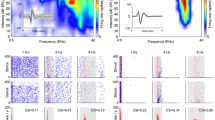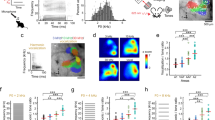Abstract
Frequency is one of the fundamental parameters of sound. The frequency of an acoustic stimulus can be represented by a neural response such as spike rate, and/or first spike latency (FSL) of a given neuron. The spike rates/frequency function of most neurons changes with different acoustic amplitudes, whereas FSL/frequency function is highly stable. This implies that FSL might represent the frequency of a sound stimulus more efficiently than spike rate. This study involved representations of acoustic frequency by spike rate and FSL of central inferior colliculus (IC) neurons responding to free-field pure-tone stimuli. We found that the FSLs of neurons responding to characteristic frequency (CF) of sound stimulus were usually the shortest, regardless of sound intensity, and that spike rates of most neurons showed a variety of function according to sound frequency, especially at high intensities. These results strongly suggest that FSL of auditory IC neurons can represent sound frequency more precisely than spike rate.
Similar content being viewed by others
References
Rieke F, Warland D, Steveninck R, et al. Spikes: Exploring the Neural Code. Cambridge: MIT Press, 1996
Wright B D, Sen K, Bialek W, et al. Spike timing and the coding of naturalistic sounds in a central area of songbirds. In: Dietterich T G, Becker S, Ghahramani Z, eds. Advances in Neural Information Processing Systems 14, Cambridge: MIT Press, 2002. 309–316
Panzeri S, Pola G, Petersen R S. Coding of sensory signals by neuronal populations: The role of correlated activity. Neuroscientist, 2003, 9(3): 175–180
Wiener M C, Richmond B J. Decoding spike trains instant by instant using order statistics and the mixture-of-Poissons model. J Neurosci, 2003, 23(6): 2394–2406
Mickey B J, Middlebrooks J C. Representation of auditory space by cortical neurons in awake cats. J Neurosci, 2003, 23(25): 8649–8663
Heil P. First-spike latency of auditory neurons revisited. Curr Opinion in Neurobiol, 2004, 14(4): 461–467
Guyonneau R, Rullen R, Thorpe S J. Neurons tune to the earliest spikes through STDP. Neural Comput, 2005, 17(4): 859–879
Rullen R, Guyonneau R, Thorpe S J. Spike times make sense. TRENDS in Neurosci, 2005, 28(1): 1–4
Heil P. Auditory cortical onset responses revisited. I. First spike timing. J Neurophysiol, 1997a, 77(5): 2616–2641
Heil P. Auditory cortical onset responses revisited. II. Response strength. J Neurophysiol, 1997b, 77(5): 2642–2660
DeWeese M R, Wehr M, Zador A M. Binary spiking in auditory cortex. J Neurosci, 2003, 23(21): 7940–7949
Mainen Z F, Sejnowski T J. Reliability of spike timing in neocortical neurons. Science, 1995, 268(5216): 1503–1506
Fricker D, Miles R. EPSP amplification and the precision of spike timing in hippocampal neurons. Neuron, 2000, 28(2): 559–569
Brugge J F, Anderson D J, Hind J E, et al. Time structure of discharges in single auditory nerve fibers of the squirrel monkey in response to complex periodic sounds. J Neurophysiol, 1969, 32(3): 386–401
Zurita P, Villa A E, de Ribaupierre Y, et al. Changes of single unit activity in the cat’s auditory thalamus and cortex associated to different anesthetic conditions. Neurosci Res, 1994, 19(3): 303–316
Irvine D R F. Physiology of the auditory brainstem. In: The Mammalian Auditory Pathway: Neurophysiology. Heidelberg: Springer-Verlag, 1991. 156–158
Phillips D P, Irvine D R. Responses of single neurons in physiologically defined area AI of cat cerebral cortex: Sensitivity to interaural intensity differences. Hear Res, 1981, 4(3–4): 299–307
Rhode W S, Smith P H. Encoding timing and intensity in the ventral cochlear nucleus of the cat. J Neurophysiol, 1986, 56(2): 261–286
Xia Y F, Qi Z H, Shen J X. Neural representation of sound duration in the inferior colliculus of the mouse. Acta Otolaryngol, 2000, 120(5): 638–643
Xiao Z, Suga N. Reorganization of the auditory cortex specialized for echo-delay processing in the mustached bat. Proc Natl Acad Sci USA, 2004, 101(6): 1769–1774
Aitkin L M, Anderson D J, Brugge J F. Tonotopic organization and discharge characteristics of single neurons in nuclei of the lateral lemniscus of the cat. J Neurophysiol, 1970, 33(3): 421–440
Kitzes L M, Gibson M M, Rose J E, et al. Initial discharge latency and threshold considerations for some neurons in cochlear nuclear complex of the cat. J Neurophysiol, 1978, 41(5):1165–82
Heil P, Irvine D R. First-spike timing of auditory-nerve fibers and comparison with auditory cortex. J Neurophysiol, 1997, 78(5): 2438–2454
Phillips D P. Factors shaping the response latencies of neurons in the cat’s auditory cortex. Behav Brain Res, 1998, 93(1–2): 33–41
Casseday J H, Ehrlich D, Covey E. Neural measurement of sound duration: Control by excitatory-inhibitory interactions in the inferior colliculus. J Physiol American, 2000, 84(3): 1475–1487
Eggermont J J. Azimuth coding in primary auditory cortex of the cat. I. Spike synchrony versus spike count representation. J Neurophysiol, 1998, 80(4): 2133–2150
Eggermont J J. Azimuth coding in primary auditory cortex of the cat. II. Relative latency and interspike interval representation. J Neurophysiol, 1998, 80(4): 2151–2161
Reale R A, Jenison R L, Brugge J F. Directional sensitivity of neurons in the primary auditory (AI) cortex: Effects of soundsource intensity level. J Neurophysiol, 2003, 89(2): 1024–1038
Furukawa S, Middlebrooks J C. Cortical representation of auditory space: Information-bearing features of spike patterns. J Neurophysiol, 2002, 87(4): 1749–1762
Author information
Authors and Affiliations
Corresponding authors
Additional information
Supported by the National Natural Science Foundation of China (Grant Nos. 30170250, 90208012, and 30270440), the Innovation Program of the Chinese Academy of Sciences (Grant No. KGCX2-SW-602-2), and Natural Science Foundation of Guangdong Province (Grant No. 32870)
Rights and permissions
About this article
Cite this article
Qiu, Q., Tang, J., Yu, Z. et al. Latency represents sound frequency in mouse IC. SCI CHINA SER C 50, 258–264 (2007). https://doi.org/10.1007/s11427-007-0020-6
Received:
Accepted:
Issue Date:
DOI: https://doi.org/10.1007/s11427-007-0020-6




